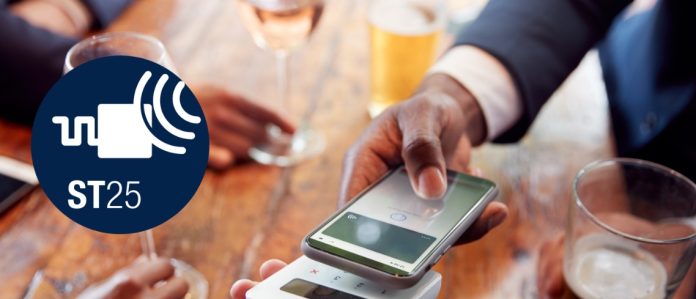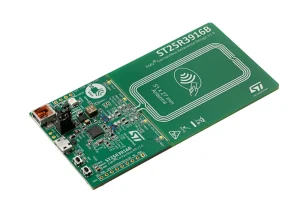ST released its newest EMVCo 3.1 device, the ST25R3916B, for consumer and industrial applications. It facilitates the creation of contactless systems for payment terminals. ST is also shipping the ST25R3916B-EMVCO, a reference design with a four-turn RF antenna. Unlike the previous generation, this new reference design doesn’t feature a display and showcases a smaller antenna to significantly reduce its physical and carbon footprint. Additionally, it can connect to custom antennas to account for various designs, such as a space-constrained payment dongle.
The democratization of contactless payment solutions demands a flawless user experience
EMV was originally the acronym for Europay, Mastercard, and Visa, the companies behind the standard’s first version in 1994. As more payment companies and financial institutions joined, EMV became EMVCo, a global consortium that supervises the development and adoption of standards regulating card payments, whether through a magnetic strip, a chip, or contactless technologies. They oversee the significant technical specifications of the various standards and define the testing and certification process to ensure that devices are truly compliant.
As smartphones and smartwatches became payment solutions, EMVCo’s new mission was to guarantee flawless interoperability between all these solutions to ensure a better user experience for vendors and consumers. EMVCo’s latest certification, the EMV Contactless interface specification v3.1a, continues to solve the challenges arising from the new NFC transmitters that the public uses to purchase goods and services.
What’s new with the ST25R3916B?
Better active waveshaping
The ST25R3916B brings more excellent active waveshaping capabilities by providing finer settings to tune the signal. Put simply, active waveshaping adjusts the signal to match PICC (Proximity Integrated Circuit Cards) references by limiting undershoots, thus enabling a faster and more efficient coupling of the reader and the card. EMVCo standards have had stricter undershoot requirements over the years, making active waveshaping even more critical. Consequently, fine-tuning the antenna becomes more complex and sensitive as poor performance can prevent a product from receiving certifications.
ST developed a graphical user interface to optimize workflows to help teams visually select registers that shape the signal and manage the undershoot and overshoot patterns. In a nutshell, when connecting the ST25R3916B to an oscilloscope, the GUI shows a wave pattern to help teams more quickly adjust their signal while monitoring the outcome. Thanks to finer settings, the whole process is faster, only taking minutes. The ST tool thus lowers the barrier to entry to help engineers get started and reduce friction in the early prototyping stages. The software is available upon request.
Heartbeat detection
The ST25R3916B also distinguishes itself with features like heartbeat detection. The functionality helps a reader identify whether it is interacting with a card or a smartphone. This is particularly useful in wireless chargers. Indeed, a Qi charger can potentially destroy regular NFC cards if it mistakes them for a phone and tries to send a charge. Thanks to the heartbeat technology patented by ST, the reader can rapidly distinguish between the two by more precisely analyzing behaviors after communication ends.
The 3 pillars of EMVCo 3.x
1. New PICC Reference Profiles
EMVCo 3.0 was a highly symbolic release because it introduced three reference PICCs (Proximity Integrated Circuit Cards) instead of just one. A PICC reference simulates a payment card to test a reader’s compatibility with the current standard. EMVCo can guarantee better terminals’ interoperability with phones and cards by adding multiple PICC references. Very simply, there are two levels of EMV certifications. EMV Contactless Level 1 ensures that the terminal meets the fundamental electromagnetic and communication protocol requirements. At the same time, Contactless Level 2 focuses on the software validation that implements the payment functionalities which run on Level 1 devices.
Under EMVCo 2.6, the Contactless Level 2 certification initially ensured interoperability between readers and mobile devices or cards. However, it was possible to pass the first level under certain use cases and still have issues during Level 2 tests. Hence, by demanding that readers be compatible with these additional two PICCs, EMVCo 3.0 now protects users against the interoperability issues that plagued EMVCo 2.6.
2. New Matching Frequencies and Loads
Another fundamental aspect introduced with version 3 was that each reference PICC required tests with two loads. On top of the original credit card size PICC tuned to 16.1 MHz, EMVCo has been mandating tests for two additional PICCs tuned to 13.56 MHz, one using a standard credit card size and the other using a design that’s about half the size to account for the smaller antennas of mobile terminals like smartwatches. Moreover, the new standard adds two loads per PICC, meaning the terminal must be tested twice for each card.
Moving to the new standard will require substantially more testing because companies must run six simulations instead of a single PICC reference. Hence, the industry is facing an uphill battle because the new standard, though necessary, makes designing a payment terminal more complex since correcting its antenna for one PICC profile may result in a new incompatibility with the other five. As a result, a device that can be tuned in minutes, thanks to a GUI, really stands out.
3. Better Signal Quality
Finally, since version 3, EMVCo has placed much more stringent regulations on the overshoot and undershoot limits. When a reader tries to couple with a PICC, there is always an energy back and forth. If we look at the waveshape of the signal on the antenna, it takes the form of an overshoot and an undershoot until the reader and PICC match. In EMVCo 2.6, terminals had an overshoot and undershoot allowance of about 10 %, whereas new EMVCo standards now limits the overhead to between 5 % and 10 %, depending on the rise/fall times. Such restrictions will ensure a better signal, but dealing with the new PICC references and all six possibilities is even more difficult than before.
How to Get Started?
The ST25R3916B-EMVCO is a reference design that greatly facilitates the creation of the contactless system of a payment terminal by offering a hardware layout and a code example for an EMVCo 3.1 level 1 stack. The kit features the ST25R3916B reader IC, and unlike the previous version, it doesn’t use a display, as the display was only used for demonstration but was not required by the engineer working on the demo kit. Furthermore, we found that most customers would remove the screen as they worked toward a small form factor. Consequently, the new device reflects the latest industry trends.
The kit, design files, recommendations, and reference code are available upon request to designers. Therefore, they can use it to learn from our implementation, reduce the number of PCBs they have to create for their prototype, and shorten their time to market. The ST25R3916B-EMVCO even includes an STM32L476 with 1 MB of Flash, allowing them to write their application layer comfortably. The board also supports STLINK-V3 to program the MCU quicker without necessarily using a dedicated probe. Indeed, developers can use the USB port to drag and drop firmware onto a virtual storage volume.
Teams that want to use another microcontroller may choose the X-NUCLEO-NFC08A1, which houses the same ST25R3916B, but on an expansion board. It includes a 47 mm x 34 mm four-turn antenna, enabling developers to start working immediately. It is, therefore, a great way to test its automatic antenna-tuning capabilities that ensure operations near metallic objects. The board supports an output power of 1.7 W, which is what most NFC applications need. Users can also download the STSW-ST25R-LIB graphical user interface to configure their ST25R devices.









